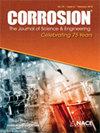社论:环境诱导的铝合金裂纹萌生和裂纹扩展的早期阶段,第二部分
IF 1.3
4区 材料科学
Q4 MATERIALS SCIENCE, MULTIDISCIPLINARY
引用次数: 0
摘要
第二组“最先进的”贡献[1-4]由特邀研究人员在“环境诱导裂纹萌生和铝合金裂纹扩展的早期阶段”上发表,补充了2023年1月发表在《腐蚀》杂志上的论文[5-8]。本文的第二部分概述了自20世纪50年代以来进行的铝合金环境诱发裂纹(EIC)启动的实验研究,表明裂纹启动通常在结构应用的使用寿命和经受常规标准EIC测试的光滑拉伸试验试样的总寿命中都占主导地位。回顾还表明,尽管过去30年的研究几乎完全集中在EIC的扩展上,但也有值得注意的例外,值得重新评估和进一步研究,使用现代现场先进的实验技术,特别关注蠕变、裂纹止裂和EIC启动过程中的表面条件的作用,特别是关注直接的次表层。本文集中的另外三篇论文是实验性研究。一项研究研究了在受控电化学条件下疲劳预裂纹和腐蚀诱导裂纹在敏感化AA5456-H116断裂力学试验中的显著差异。最后两篇论文涉及对高Zn含量Al-Zn-Mg-Cu 7xxx系列合金[3,4]的测试:一篇论文涉及两种厚坯商业高Zn含量新一代合金[3]、AA7449和AA7085在T7651状态下的测试,并详细描述了70℃水蒸气暴露时EIC的起始和向长裂纹扩展的转变。从大面积的现场延时光学成像中收集到的信息,可以通过高分辨率断口学研究来确定和调查确切的起始位置。基于同步辐射x射线断层扫描原位观察到的高zn含量Al-Zn-Mg-Cu 7xxx合金的变形和断裂行为,提出mn基第二相颗粒的分散可能为防止7xxx系列铝合金的氢脆提供一种新的方法。本文章由计算机程序翻译,如有差异,请以英文原文为准。
Editorial: Environment-Induced Crack Initiation and Early Stages of Crack Growth in Aluminum Alloys, Part 2
A second group of ‘state-of-the-art’ contributions [1-4] by invited researchers on the ‘Environment-Induced Crack Initiation and Early Stages of Crack Growth in Aluminum Alloys’ appear in this issue, complementing the papers published in the January 2023 issue of Corrosion [5-8]. The second section, presented herein, includes an overview of the experimental study of the initiation of environment-induced cracking (EIC) in aluminum alloys conducted since the 1950’s [1], showing crack initiation typically dominates the total life experienced during both service-life for structural applications and for smooth tensile test specimens subjected to conventional standard EIC testing. The review also reveals, although research conducted over the last 30 years almost exclusively focus on EIC propagation, there are notable exceptions worthy of re-evaluation and further study using modern in-situ advanced experimental techniques, paying particular attention to the roles of creep, crack-arrest and surface conditions during EIC initiation, paying particular attention the immediate sub-surface layers. The three additional papers in this collection are experimental studies. One investigates the significant differences in EIC initiation observed from fatigue pre-cracks and corrosion-induced fissures under controlled electrochemical conditions in a sensitized AA5456-H116 fracture mechanics test specimen exposed to a marine environment [2]. The final two papers involve testing conducted on high Zn-content Al-Zn-Mg-Cu 7xxx series alloys [3, 4]: one involves two commercial thick pate commercial high Zn content new-generation alloys [3], AA7449 and AA7085 in the T7651 temper and provides a detailed description of EIC initiation and its transition to long-crack growth during exposure to water vapor at 70 °C. Information gleaned from in-situ time-lapse, optical imaging over large areas has enabled the exact initiation sites to be identified and investigated with high-resolution fractographic studies. In the final paper [4] based on the deformation and fracture behavior of a high Zn-content Al-Zn-Mg-Cu 7xxx alloy observed in situ using synchrotron radiation X-ray tomography, it is proposed the dispersion of Mn-based second-phase particles may offer a novel approach for preventing hydrogen embrittlement in 7xxx series aluminum alloys.
求助全文
通过发布文献求助,成功后即可免费获取论文全文。
去求助
来源期刊

Corrosion
MATERIALS SCIENCE, MULTIDISCIPLINARY-METALLURGY & METALLURGICAL ENGINEERING
CiteScore
2.80
自引率
12.50%
发文量
97
审稿时长
3 months
期刊介绍:
CORROSION is the premier research journal featuring peer-reviewed technical articles from the world’s top researchers and provides a permanent record of progress in the science and technology of corrosion prevention and control. The scope of the journal includes the latest developments in areas of corrosion metallurgy, mechanisms, predictors, cracking (sulfide stress, stress corrosion, hydrogen-induced), passivation, and CO2 corrosion.
70+ years and over 7,100 peer-reviewed articles with advances in corrosion science and engineering have been published in CORROSION. The journal publishes seven article types – original articles, invited critical reviews, technical notes, corrosion communications fast-tracked for rapid publication, special research topic issues, research letters of yearly annual conference student poster sessions, and scientific investigations of field corrosion processes. CORROSION, the Journal of Science and Engineering, serves as an important communication platform for academics, researchers, technical libraries, and universities.
Articles considered for CORROSION should have significant permanent value and should accomplish at least one of the following objectives:
• Contribute awareness of corrosion phenomena,
• Advance understanding of fundamental process, and/or
• Further the knowledge of techniques and practices used to reduce corrosion.
 求助内容:
求助内容: 应助结果提醒方式:
应助结果提醒方式:


